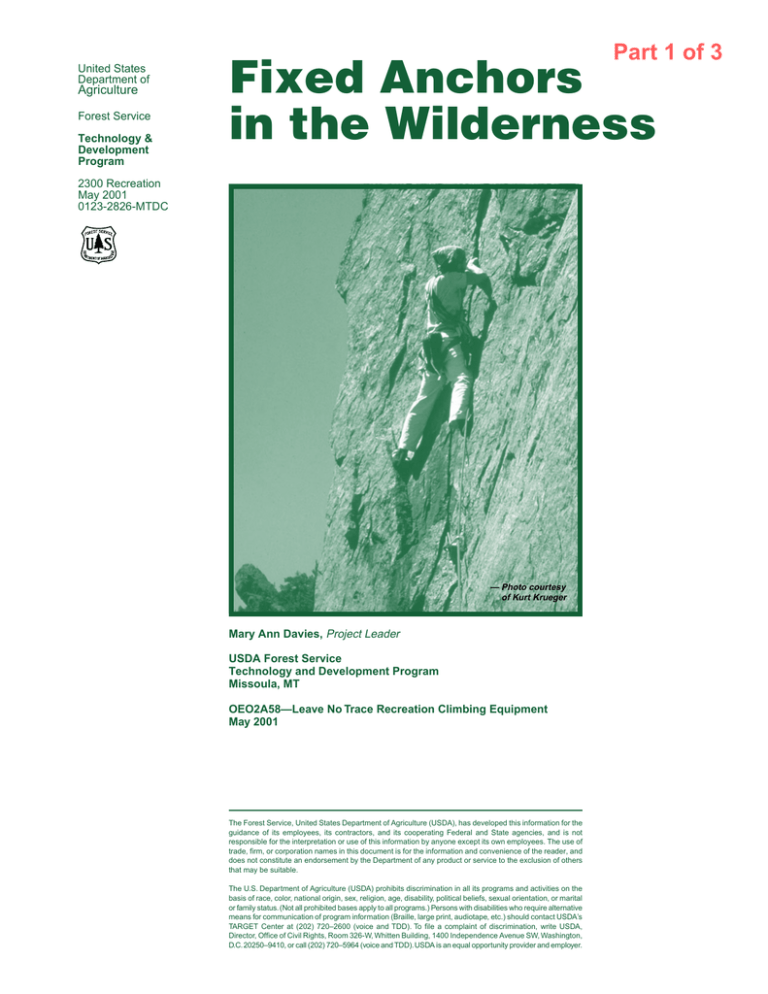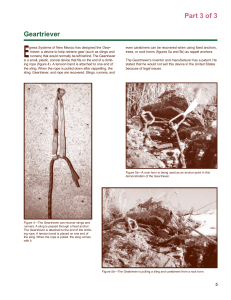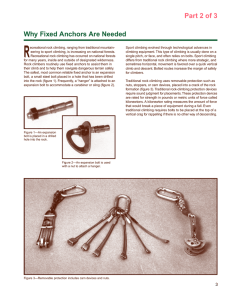Fixed Anchors in the Wilderness Part 1 of 3 Agriculture
advertisement

United States Department of Agriculture Forest Service Technology & Development Program Part 1 of 3 Fixed Anchors in the Wilderness 2300 Recreation May 2001 0123-2826-MTDC — Photo courtesy of Kurt Krueger Mary Ann Davies, Project Leader USDA Forest Service Technology and Development Program Missoula, MT OEO2A58—Leave No Trace Recreation Climbing Equipment May 2001 The Forest Service, United States Department of Agriculture (USDA), has developed this information for the guidance of its employees, its contractors, and its cooperating Federal and State agencies, and is not responsible for the interpretation or use of this information by anyone except its own employees. The use of trade, firm, or corporation names in this document is for the information and convenience of the reader, and does not constitute an endorsement by the Department of any product or service to the exclusion of others that may be suitable. The U.S. Department of Agriculture (USDA) prohibits discrimination in all its programs and activities on the basis of race, color, national origin, sex, religion, age, disability, political beliefs, sexual orientation, or marital or family status. (Not all prohibited bases apply to all programs.) Persons with disabilities who require alternative means for communication of program information (Braille, large print, audiotape, etc.) should contact USDA’s TARGET Center at (202) 720–2600 (voice and TDD). To file a complaint of discrimination, write USDA, Director, Office of Civil Rights, Room 326-W, Whitten Building, 1400 Independence Avenue SW, Washington, D.C. 20250–9410, or call (202) 720–5964 (voice and TDD). USDA is an equal opportunity provider and employer. 1 Part 1 of 3 Introduction A llowing fixed anchors, expansion bolts, and hangers in designated wilderness is controversial. Advocates of fixed anchors believe the anchors are essential for safety. Opponents of fixed anchors in wilderness base their argument in the statutory language of the Wilderness Act of 1964, which prohibits “installations” for other than administrative purposes. These opponents consider fixed anchors to be prohibited installations. The Missoula Technology and Development Center (MTDC) was asked to conduct a market search of existing climbing hardware to find a feasible substitute for fixed anchors, or to develop a new piece of equipment that would eliminate the need for fixed anchors. The Center found no substitute that could do the job as safely or effectively as fixed anchors. The rock climbing community and industry are also searching for alternative climbing equipment, so far without success. Development of a replacement product is best left to the private sector due to liability issues and the fact that climbing is a recreational—rather than an administrative—activity. MTDC did find one product, the “Geartriever”, that would retrieve gear (such as slings and runners) that normally would be left behind. The likelihood of finding a technical solution that would make fixed anchors obsolete is slim. The Center will continue to monitor the negotiated rulemaking on fixed anchors. We will also continue to look at new climbing gear. 2




